Building Frankie Jo: How years of work took this retro caravan from mouldy to road-ready
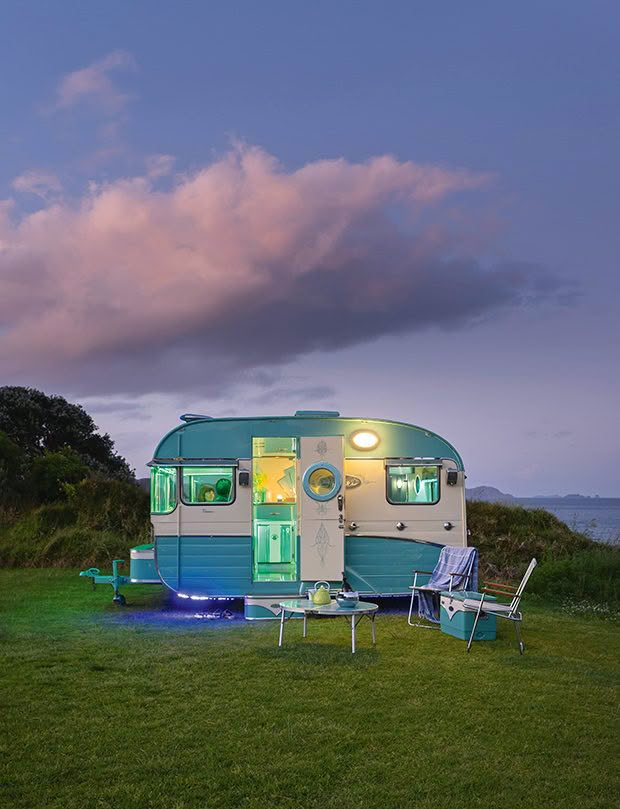
Matching vintage speakers were hard to find but perfect for the Beach Hop-vibe music Kate and Tony enjoy, as were the vintage cool box and toolbox (on the front of Frankie Jo).
Hundreds of old-school caravans have been restored and returned to the roads in recent years. Each reflects the personality of its owner in a kaleidoscope of ways — and is infinitely interesting for it.
Words: Kate Coughlan Photos: Tessa Chrisp
“Oh no,” groaned Tony Bartlett when his wife Kate spied the mouldy caravan in a Maketu paddock. “It was almost buried in tall grass. Its floorboards were missing, and windows smashed. I couldn’t believe Kate wanted to buy it.”
Kate, who has spent much of her life as an antique dealer, and Tony had only recently sold a 14-foot (sorry, metric people, vintage vans only come in Imperial) 1962 Princess caravan they had restored. A week earlier they had taken possession of another in need of restoration. Their retro caravan hobby had been inspired by seeing one called Get Rhythm at a Whangamatā Beach Hop, owned by Mike Wells of Retro Custom Caravans of Whakatāne.
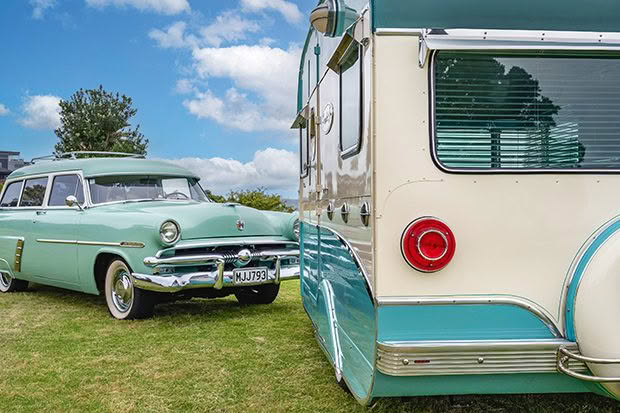
Photo: Troy Baker
“The beginning of the addiction,” says Kate. “I could barely drive past one for sale without stopping.” And in the wreck that had come from a Bay of Plenty paddock Kate could see potential. “I loved the shape of her, especially the corner windows. I could see it restored.”
Tony, a former farmer and now stock-food representative, is a very handy fellow. But he was unequivocal, staring at the 12-foot 1963 Princess wreck of a thing, that what lay ahead for whoever embarked on its restoration was work, work and more work.
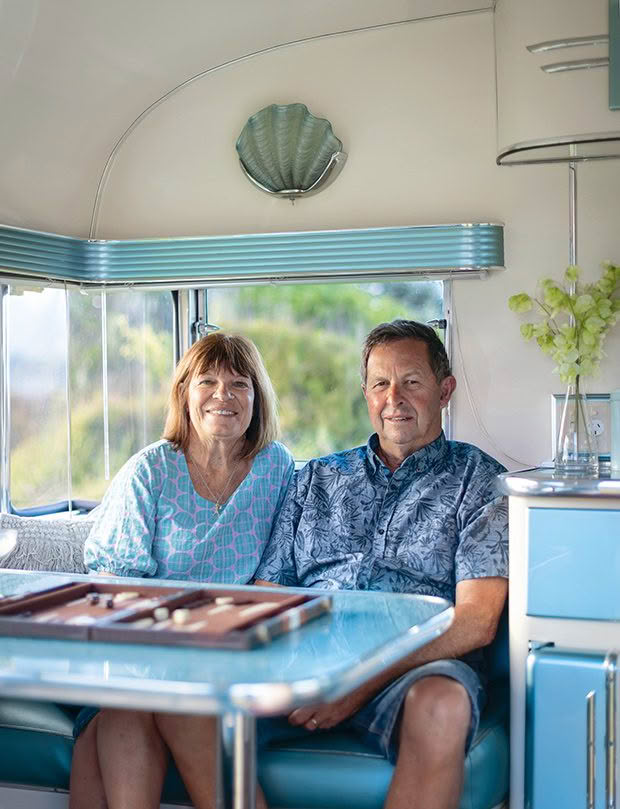
Kate photographed it, pinned the photographs on her wishboard and worked on Tony to buy it. Unsuccessfully. He knew too well that Kate’s highly honed aesthetic eye would go to town on this little one. He could feel her excitement; there, winking at him from those photographs.
Sometimes a wishboard can prove more potent than even the strongest male resolve. The planets lined up obediently, Kate haggled with caravan owner, and suddenly, the Bartletts were owners of the rumpty Princess, formerly of the paddock. “Sorry,” she told Tony, “I’ve bought it.”
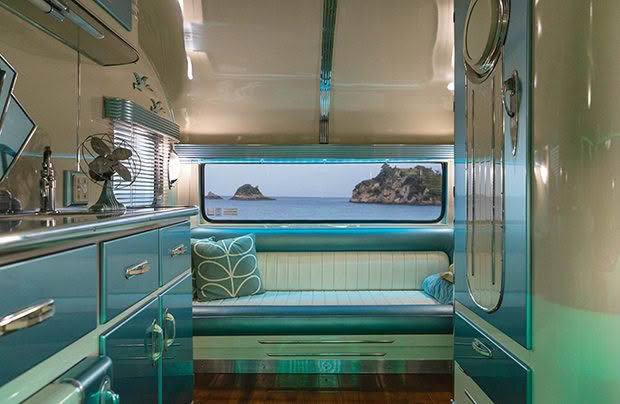
Weight is always an issue with caravans, so the carefully stained plywood floor (Kate’s handiwork to match the art deco theme) is just 10 millimetres thick. Tony made the elegant pelmets from polished aluminium. The more you look, the more you see in the intricate embellishments; the vintage aluminium fan, the hand-pump tap (freshly chromed), the wardrobe door with chrome flashes and a porthole…
Tony’s head went back into his hands. “Oh no,” he moaned. “What were you thinking?” (Actually, he knew exactly what she was thinking, and that was the problem.)
“I wouldn’t know where to start with my passion for caravans,” she says. Perhaps it began with her childhood in Scotland when her parents took her and three siblings camping each year in a Dormobile (the popular British pop-top Bedford). Tony’s parents, concurrently, were taking him and his siblings on camping holidays to Mount Maunganui in the family’s yellow Pontiac sedan towing a lemon-coloured 1950s Muir caravan.
Fast forward: The year is 2016, and in a shed near Ōhope (Kate and Tony’s hometown in recent years), work is underway on the sad shell of the little Princess. It is painstaking, laborious and challenging, even for Tony, who cut his restoration teeth working with Kate in their antique business, originally in Hunterville.
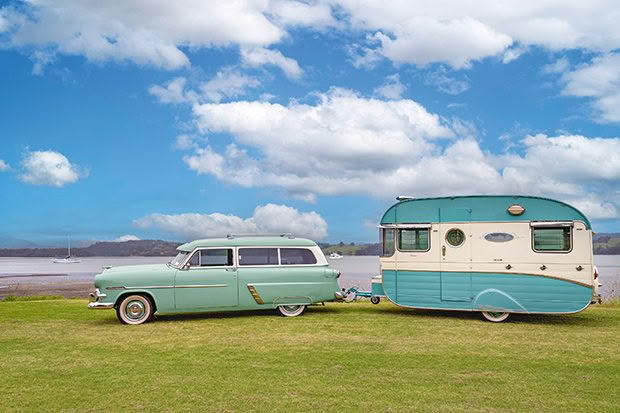
In California, classic-car buff Squeak Bell of Kawarau found the couple the perfect towing wagon. People often toot at the 1953 Ford Ranch Wagon and the little Princess in their eye-catching matching colours, and when parked, they usually draw an admiring crowd.
They’d come to the Bay of Plenty on a tenting holiday, fallen in love with the region and purchased 15 acres of land (6.7 hectares), planted avocados (and lost that orchard to floods), replanted with figs and citrus and made a living as horticulturists. They sold the orchard and bought a home in Ōhope overlooking the harbour and the hills. He’d become a stock-food salesman, and she’d taken on a ladies’ clothing boutique in Whakatāne called Capiz. They also fell out of love with tenting.
“After too many rained-out tenting holidays, we said, ‘Oh, bugger this, let’s get a bit more comfortable’, which led to our infatuation with vintage caravans.”
Back to that shed in Ōhope. Tony is struggling with the complex lines of the Princess, the very thing that makes Kate love it so much. With five vintage van restorations under his belt, he’s familiar with the challenges. But the sloping ceiling, gorgeous curves and cute corner windows are giving him a headache and pushing his skills to the limit. He relines the interior, then crafts cardboard models of interior furniture such as pelmets and cupboards to ensure they fit and are correctly proportioned. When satisfied everything is perfect, he begins the real ones. When he’s done, the only original piece left is the wardrobe. And that gets a facelift any surgeon would be proud to own.
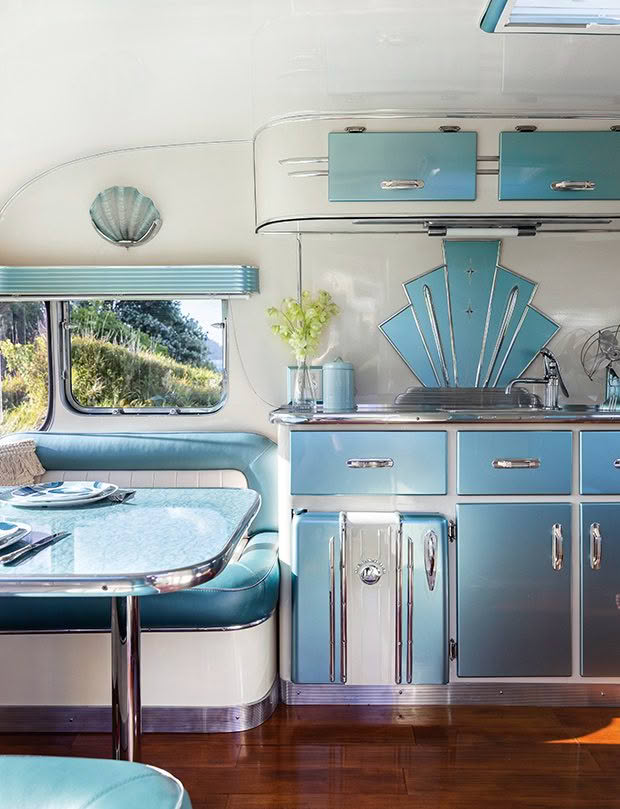
An art deco-inspired sink splashback, created after a Pinterest session, set the theme for the restoration of Tony and Kate Bartlett’s retro caravan. Chrome and polished aluminium marry well with the Cracked Ice vinyl wrap specially made for the benchtop, dining table and two occasional tables.
Kate, meanwhile, is hunting down bits and pieces to ensure sovereign status for their little Princess. It is a small van, so her restraint is as masterly as her reach. From London comes a pair of shell-shaped lights from an Odeon movie theatre. They are spray-painted by the formerly reluctant seller of the little Princess (and, by this time, firm friend and fellow restorer on the project, Mike Wells). When he delivers the freshly painted lights, Kate feels tears of joy prickle her eyes. They are perfect. Collecting carries on apace, often online, and Kate’s magpie eye for shiny things prizes chrome car adornments from the 1950s. Vehicles of that era were generously embellished with chrome artwork.
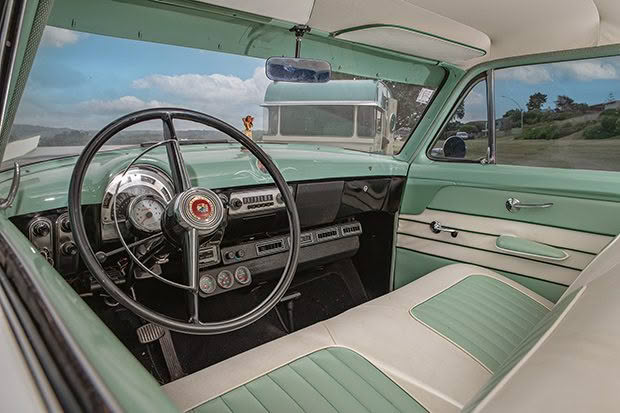
Two years of hunting finally unearth the perfect tap. A pumping kitchen tap discovered at a Napier junkyard is chromed to meet Kate’s standards of “perfection”. So much so that she purchases the matching tap, so she always has a spare. “Who spends two years hunting down a tap?” asks Tony. But Kate is too occupied to hear. She’s busy chasing down a chrome smoker’s table on which she plans to plonk her glass of plonk in imagined moments of future relaxation. She’s found one on Trade Me, but Tony is unusually reluctant to push the bid button.
“Shall I bid?’ she asks again and again. Secretly, he’s busily re-chroming a hub cap, inserting a stainless pole, and chrome-edging a vinyl-covered tabletop to create a replica smoker’s table. He wants to surprise her.
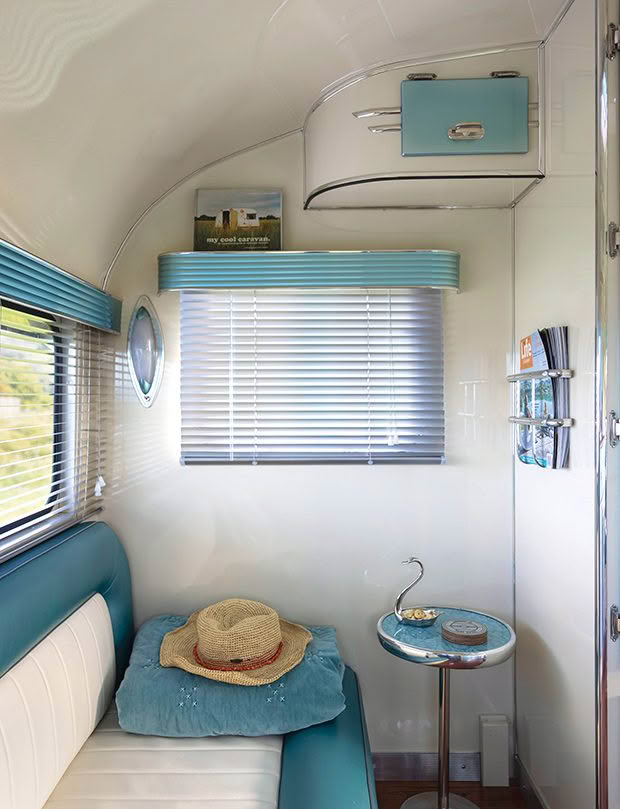
The rear sofa, upholstered by Dave Howard of Matamata to match the Ford’s interior, folds down to a king-single bed. While Kate and Tony are not big people, it is a bit snug, so they usually sleep in the awning. The curved windows initially drew Kate’s attention and made Tony’s restoration a bit of a nightmare. Making cardboard models of all interior fittings before building the real ones ensured everything was proportional. Various pieces of chrome decorating the exterior came from a 1950s Chevrolet Bel Air and from online auctions.
Her eyes well with happy tears when he finally presents her with it. It’s perfect. The little swan ashtray that sits today filled with lollies rather than butts is also perfect. As are the trio of tiny wooden ducks, painted teal and in perpetual flight above a rear side window.
Four years tick by as the list of to-dos gets ticked off until it is perfectly ready for the road. Then comes Covid-19 in March 2020 and puts paid to their planned holiday in the caravan, named Frankie Jo, at the popular Whangamatā Beach Hop in March, where there’s a particular class for retro caravans.
When they made it to the Beach Hop in November 2020 Frankie Jo was voted Best Caravan from a class of more than 100 retro caravans. “She’s it now,” says Tony, “no more caravan restoration.” Kate agrees that Frankie Jo is everything they want — for now. “It is old-school camping, and we love to see so many of these old caravans being restored and back on the road again where life is so free and simple.”
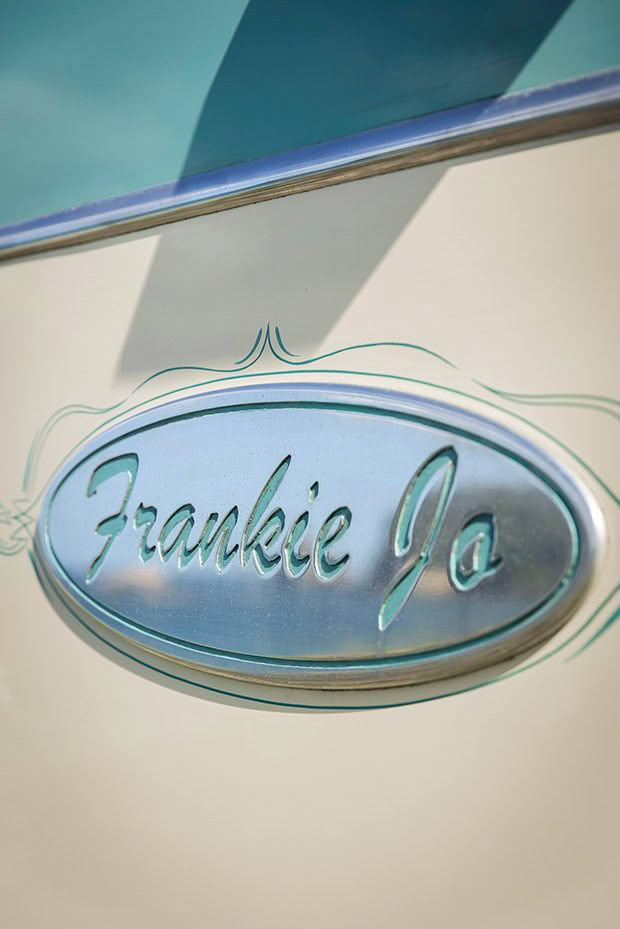
WHAT IS A RETRO CARAVAN?
Ideally, caravans must be pre-1970s to be classified as vintage/retro. Some 1970s models have been restored with a retro finish and look very good. The Whangamatā Beach Hop retro event will be held from 22 to 26 March 2023, with caravans open on Saturday for public viewing and voting.
ARE THEY COSTLY TO RESTORE?
Kate and Tony don’t know how much they spent renovating the Princess as they stopped recording it after $60,000. “We did get carried away,” Kate says. The New Zealand Retro Car & Caravan Club has approximately 3000 members.
WHY FRANKIE JO?
“We named it after the lovely daughter of a friend, and we thought it had the vibe of the era. With seven beautiful granddaughters, we couldn’t possibly choose just one of their names.”
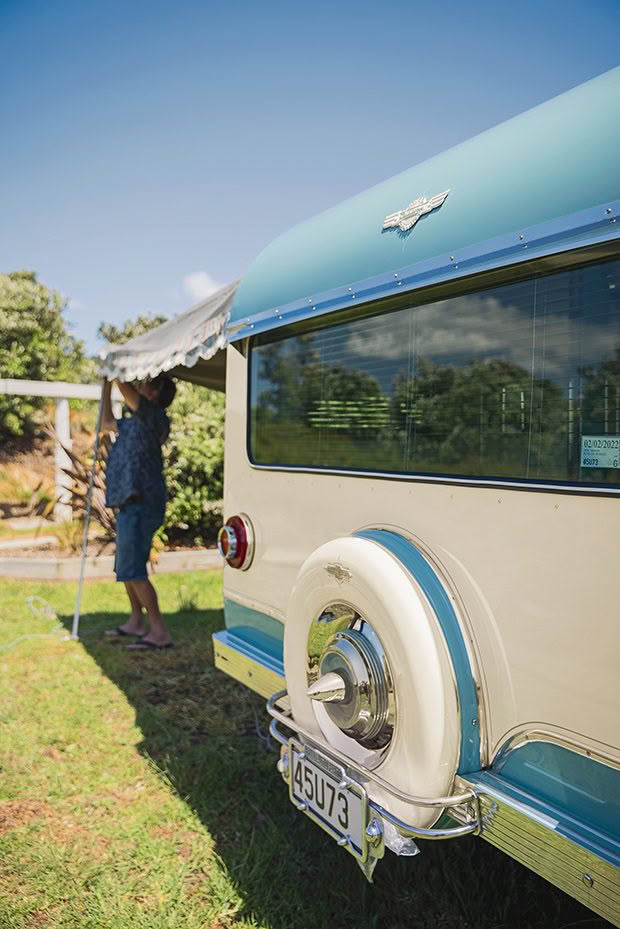
Kate says “Frankie Jo has a lovely bottom”, and likes to take people to the rear to admire the handiwork of Mike Wells of Retro Caravans in Whakatāne. In addition to all paintwork, Mike also created the continental kit for the spare wheel.
PLAYING FAVOURITES
Favourite campground? “Hahei Beach Resort, the motor camp on the beachfront with a beautiful beach and lovely islands just offshore. We love wandering along to the Pour House for a pizza and a glass of wine, walking to Cathedral Cove and going to nearby Hot Water Beach.”
Favourite activities on a caravan holiday? “Playing backgammon, getting away from screens, including television (we’re old-school, no electronics), playing Scrabble, having a glass of wine, going for walks, doing a bit of fishing and chilling out — recharging the batteries.”
Your future plans for Frankie Jo? “We intend to retire — though we say that every year and never do — and take Frankie Jo on a long holiday around the South Island. Our real goal is to spend more time away from work and on the road.”
THE HISTORY OF PRINCESS VANS
Princess caravans were built in the same Dunedin factory as Zephyr caravans. It is thought there are not many left today as perhaps not many were manufactured. They have rounder lines than the Zephyr brand. Despite research, Kate has found out very little about the Princess make.
Love this story? Subscribe now!
 This article first appeared in NZ Life & Leisure Magazine.
This article first appeared in NZ Life & Leisure Magazine.
